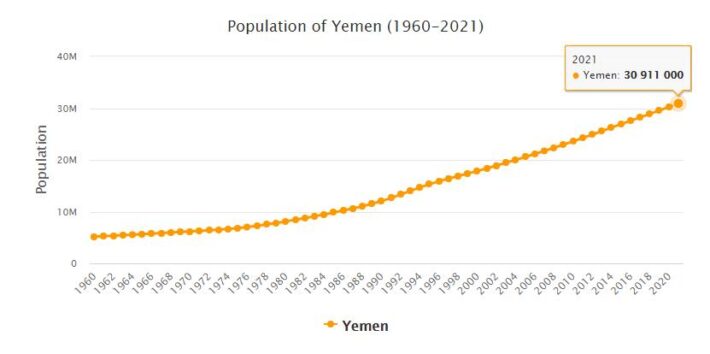Yearbook 2012
Yemen. The country was plagued during the year by instability, fighting and famine. Acting President Abd Rabbuh Mansur al-Hadi received 99.8% of the vote in the February 21 presidential election. He met no challengers. At least four people were killed in the election and several polling stations were attacked. When al-Hadi was sworn in to his post on February 25, 25 members of the Republican Guard were killed in the port city of al-Mukalla in the south.
- AbbreviationFinder.org: Provides most commonly used acronyms and abbreviations for Yemen. Also includes location map, major cities, and country overview.
Economy
| Inflation rate | 24.70% |
| Unemployment rate | 27% |
| Gross domestic product (GDP) | $ 73,630,000,000 |
| GDP growth rate | -5.90% |
| GDP per capita | 2,500 USD |
| GDP by sector | |
| Agriculture | 20.30% |
| Industry | 11.80% |
| Service | 67.90% |
| State budget | |
| Revenue | 7.363 billion |
| Expenditure | 7.199 billion |
| Proportion of the population below the national poverty line | 54% |
| Distribution of household income | |
| Top 10% | 30.8 |
| Lower 10% | 2.9 |
| Industrial production growth rate | -27.00% |
| Investment volume | 19.7% of GDP |
| National debt | 74.50% of GDP |
| Foreign exchange reserves | $ 245,100,000 |
| Tourism | 2013 |
| Number of visitors | 990,000 |
| Revenue | $ 1,026,000,000 |
Outgoing President Ali Abdullah Saleh left the country in January but returned in time for the election. Saleh, his family and closest associates enjoyed full prosecution immunity for all the exercise of power during his 33 years as president. According to the opposition within the JMP (United Party meeting), Saleh assumed the role of “shadow president”. Several of his relatives held their high positions in the security apparatus and protesters demanded on several occasions that their immunity be revoked. In April, Hadi tried to dismiss some of Saleh’s relatives from high military posts, but he met armed resistance. In August, he made another attempt when he established a new military unit, the President’s Security Force, which was in charge of those parts of the Republican Guard that were still controlled by Saleh’s family.
After severe international pressure, Saleh left the post of leader of the ruling party, the General People’s Congress (GPC). He was expected to be succeeded by Hadi but during a transitional period, Deputy Party leader Abdal Karim al-Iryani was appointed new party leader.
Violent fighting with a total of hundreds of dead raged in the northern parts of the country between Shiite Muslim rebels from the al-Huthi clan and government soldiers as well as militant Salafists. Even tougher fighting raged in the south between government troops, sometimes backed by US driverless drones, and the so-called Ansar al-Sharia Brigade within the al-Qaeda network on the Arabian Peninsula (AQAP). 185 government soldiers and 32 jihadists were killed on March 4 when Ansar al-Sharia attacked two military facilities near the coastal city of Zinjibar. Violence escalated; In April 200 people were killed during a week and on May 21 over 100 soldiers were killed in a suicide bombing in connection with a military parade in the capital Sana. By mid-June, the government had taken control of both Zinjibar and Jaar, another nearby city,
Ansar al-Shariah also endeavored to win the support of the people in the poor southern part of the country. They distributed food, repaired water pipes and expanded the infrastructure. At the same time, relatives also compensated victims of the American drone attacks. The strategy was judged to be successful.
A number of foreigners were kidnapped during the year, among them a UN-employed Norwegian who was abducted in Sana on January 15 but released just two weeks later, and two Finns who were abducted in December.
Foreign Policy
The relationship with Oman has traditionally not been good, but in the late 1980s there was a reconciliation between South Yemen and Oman. This paved the way for a 1992 border demarcation agreement; in 1993 the border was opened.
During the liberation war in Eritrea, Yemen in the 1980s welcomed thousands of refugees from there. In 1995 there were military meetings between the two countries; the conflict revolved around control of the Hanish Islands. In 1998, the International Court of Justice in The Hague granted Yemen control over the majority of the islands.
Opposites
Yemen is a traditionally bound society, where both political organization and public governance within modern structures have a short history. Traditional power relations, and loyalty to the tribe and clan, are strong, not least in the countryside.
Cultural conflicts especially related to religion, including a separation between Sunnis and Shi’ites, have contributed to the uprising in the north. When integration between the two states did not emerge in the 1990s, this was due to both cultural differences and unfulfilled expectations of developments in the south.
The dissatisfaction with how the southern part was addressed within the United States led to political resistance and armed struggle – and to the southern part of the country trying to break out after a civil war. This rebellion was suppressed, but political tensions have persisted, giving rise to several impacts – including military rebellion in the north and political opposition in the south. In addition, political tension and violent actions are the result of the activities of radical Islamists.
Population 2012
According to countryaah, the population of Yemen in 2012 was 26,497,778, ranking number 50 in the world. The population growth rate was 2.730% yearly, and the population density was 50.1882 people per km2.
